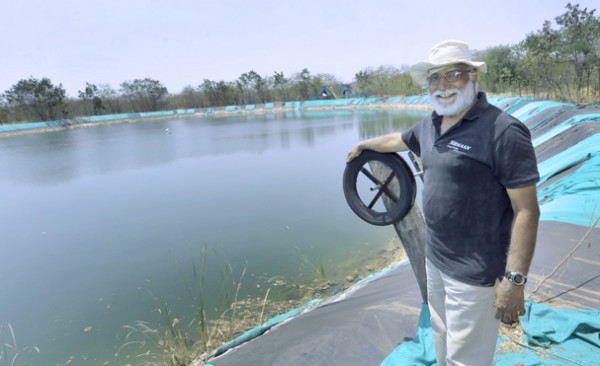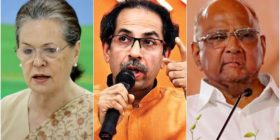The land is tawny as far as the eye can see. On the Pune-Solapur expressway, mirages are puddles of molten glass, sluggish and viscous. The sky is a bleached blue and the sunshine merciless. This land holds death, and life, too.
Off the road to Bijapur is Kusur village. This is border country, Adil Shahi country. The graffiti say Jai Maharashtra, but almost half the population speaks Kannada, too. The road winds past racks of drying raisins and tiny shelters thatched with dried sugarcane leaves. Itinerant labourers working the sugarcane fields stay here.
The late Raosaheb Shankar Waghmare’s house is flanked by drying vineyards. He committed suicide by drinking pesticide on March 28; South Solapur taluk’s first farmer suicide. His sons Ogsiddh, 25, and Mahasiddh, 20, said the family had borrowed more than 010 lakh from different sources.
Hanumantrao Kulkarni, leader of the local farmers’ group, said water restrictions and not crop failure killed Waghmare. “This is fertile land between the Krishna and Bhima rivers. We can see the water, but we cannot take it,” he said. Rajendra Mallikarjun Birajdar, a local farmer, said their water pumps on the Bhima river have been sealed and power to farm connections has been restricted to two hours a week, starting April 1. Domestic power connections receive only eight hours of power a day, residents said. But, across the river, in Karnataka, the pumps are on almost throughout the day.
A farmer who did not wish to be named said: “This is happening in [Union Home Minister Sushilkumar] Shinde’s constituency. The situation is the same in the neighbouring Madha, [Union Agriculture Minister Sharad] Pawar’s constituency.” South Solapur MLA Dilip Mane told THE WEEK that his sympathies were with the farmers, but water restrictions were enforced to ensure drinking water in the coming months.
To see a man who has moved a mountain, THE WEEK rewound the journey 30km, stopped at Kurul and took the blacktop to Ankoli. For four kilometres, the land was the same, dry and dusty. And then, just before Ankoli, a burst of green—a forest of subabul, ber, neem and mooshak mar. And, among the trees stood a grinning man in white, his trousers a few inches too short for him, his hair and beard silver.
The gate to the property was both forbidding and welcoming. It says that the Maharashtra Tourism Development Corporation recognises the property as a science village, the first ever in the state. And, there is another message on a much smaller, grey board, hand-written with an indelible marker: “The other day, a family member of ours drank pesticide and died. We are mourning him. Please do not disturb us.”
Sumangala and Arun Deshpande have not celebrated Diwali or Dussehra for years in solidarity with the grieving families of farmers. Ask for a description of themselves, and, Arun, 67, laughs: “Gandhians, maybe? Energy auditors, science communicators and farmers on strike, surely.” Perhaps, it would be best to call the Deshpandes farmers of inconvenient truths, a badge that they wear with pride.
And, if you need water to swallow those painful truths, the Deshpandes will give you that, too—four crore litres of water. That is how much the Deshpandes hold in their now famous water bank.
The Deshpandes have a long history in Ankoli, as representatives of the Adil Shahis. Arun’s schooling was split between the Haribhai Deokaran School, Solapur, and the Bhave School, Pune. “In Bhave School, I became a supporter of the Rashtriya Swayamsevak Sangh,” he said. “We raided deserted Muslim cemeteries yelling Jai Shivaji Maharaj and so on. What do children know, after all? Most sadly, I hated Gandhiji.” It would be a long time before he fell in love with the father of the nation. He did his BSc. in agriculture from Mahatma Phule Krishi Vidyapeeth in Pune, where his father taught. He would later gain a diploma from the Water and Land Management Institute, Aurangabad.
It was in Pune that he met Sumangala, a BSc. zoology graduate turned trade union activist. Arun says his alternate lifestyle is possible because of this Thane-born daughter of a doctor. “Which other city-born girl would want to come and stay here?”
The Deshpande home is a cross between a tent and a tree house. The main supports are living trees, the walls and the floors are compressed mud, covered with rush mats and the netting used to roof greenhouses.
There are tools everywhere, spanners, nail-guns, saws, hammers and screwdrivers. A small blue globe sits on a desk, amidst books on food and farming. A closer look shows that it is a map of the sky. Numerous dusty award plaques litter a desk. “Every civilised home must have a tool board, yes?” said Arun.
He has worked as a marketing officer for a fertiliser firm, an entrepreneur and even as a van driver. For a short while, the Deshpandes were market researchers and they worked with NGOs, too—chapters they would like to forget.
Arun says that the turning point was working among Bangladeshi refugees of the 1971 war in Dandakaranya, which was becoming a Naxal hotspot. “We saw the aftermath of war,” said Arun. “So, I could never pick up a gun. And, the likes of Annasaheb Sahasrabuddhe and Baba Amte convinced me that the charkha is more powerful….”
Eventually, the Deshpandes would spend four years with the Amtes. Then came a stint with people’s science movements in the country, an assignment that they cherished. And then, in 1986, the return to Ankoli.
Currently, on their 52-acre plot, the Deshpandes are promoting ‘rurban living’, a synthesis of the rural and urban ways of life. Almost half the land is under agro-forestry. The farm is a series of banks—water bank, soil bank, shelter bank, green energy bank, scrap bank, food bank and wisdom bank.
The five-acre, tarpaulin-lined water bank stores rainwater and the water pumped from a 70ft well on the farm. The Deshpandes will not sell the water, neither will they use it to grow food for sale. “Selling food means selling water,” said Arun. “One egg takes 600 litres of water, a kilo of sugar 4,000 litres….” Arun is ready to sell food only at the 1970 rates. “That is 100kg jowar = 400 litres of diesel or a tola of gold,” he said with a grin.
A firm believer in thermodynamics, Arun says the only way ahead is to reduce reliance on petroleum. “Can a solar panel or wind turbine repay its own cost in energy?” he asked.
So, on the farm he promotes bullock-powered pumps and the unique ‘baizel tractor’—where a diesel engine powers the rotary blade and a bullock tows the machine. Then there are wonders like the foot-powered iPad charger made from an old sewing machine! The farm can totally support 100 families, said Arun. All prototype homes for the upcoming science tourism village are roofed with thatched geodesic domes based on system theorist Buckminster Fuller’s design. After the earthquake in Kutch in 2001, the Deshpandes toured the region for two years, propagating these domes.
Thanks to Arun’s agro-forestry, nine wells in the village are full now. So much so that his neighbours have planted pomegranates. Ankoli sarpanch Sajjan Pawar said the Deshpandes had agreed to hold a cattle camp for 1,000 head of cattle and around 100 families. Arun now wants the sustainable Ankoli or SolaRpur model to be replicated all over the state, and the Maharashtra Knowledge Corporation has bought the water bank’s intellectual property rights from him. Why SolaRpur? “Because a farmer is the most efficient harvester of solar power. He collects the dispersed energy and gives it to you as food,” said Arun.
Please follow and like us:






Leave a reply